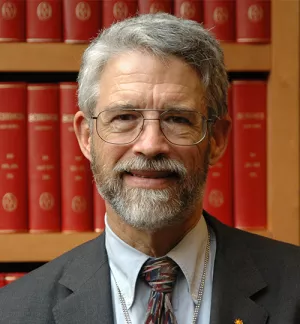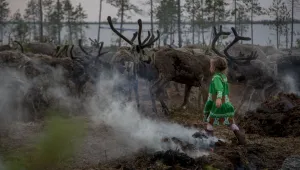This report was produced by the Department of Homeland Security Science and Technology Directorate on May 8, 2023, based on a workshop co-organized with the Arctic Initiative as well as the Directorate's further considerations. The Arctic Initiative published a summary of the workshop’s findings on ocean issues, infrastructure, human health and security, and cross-cutting science and technology solutions.
Executive Summary
The U.S. Department of Homeland Security (DHS) has broad national security and resiliency mission responsibilities in the Arctic. Rapid climate change in the Arctic is impacting all DHS missions. To examine the policy, mission, and science research requirements necessary to support resiliency and public safety in the face of this rapid change, the Science and Technology Directorate (S&T) co-hosted a workshop on May 8, 2023, with the Arctic Initiative at the Harvard Kennedy School’s Belfer Center for Science and International Affairs. The workshop focused on the effects of rapid climate change on the U.S. Arctic and Alaska, with an emphasis on resiliency, public safety, and impacts on Indigenous Alaskan communities. This workshop brought together representatives from S&T and DHS components, other federal agencies, academia, public and private agencies working in Alaska on climate related issues, and representatives and leaders of Indigenous Alaskan communities.
This report summarizes the workshop and indicates possible future directions. Though it contains policy recommendations offered at the workshop from some participants, including some public officials, it does not reflect the official position of DHS or any of its components, or of the U.S. government. It is intended to capture statements and (provisional) positions from the workshop and should be taken as such. In this report, statements and positions should be taken only as those of relevant participants (whether or not they are clearly labeled as such).
Participants in the workshop emphasized that the profound and accelerating effects of rapid climate change are inflicting a great deal of damage on the already limited infrastructure in this region. The damage is affecting the economy of the region, the stability of long-established and important communities, and the physical and cultural health and well-being of the residents. The damage is also hampering disaster relief efforts and adding to the cost of mitigating and preventing further damage. There has been, and will continue to be, widespread destruction of local communities requiring large scale rebuilding, and when the location has become no longer tenable, the wholesale relocation of residents.
The retreat of the Arctic sea ice is opening previously inaccessible areas of the Arctic Ocean to navigation as well as resource exploration and extraction. This is a growing challenge for environmental protection, the regulation of commerce in the U.S. Arctic region, and border security. These new challenges have exposed gaps in communications, weather monitoring, and situational awareness in the region.
The federal government in general, and DHS in particular, are tasked with providing policies and assistance to combat the ongoing climate crisis in this vital region. This will require both prevention and an innovative and flexible response. Prevention will require:
- Engagement with communities, including the sharing of relevant information.
- Technical assistance and strengthening supply chains.
- Continuing research and incorporating Indigenous knowledge.
- Regulation designed to reduce risks and encourage new solutions.
- Innovation and technology transfer.
- Funding to promote protective measures and capacity building.
Initiatives in these categories have helped to orient the work DHS is doing to address climate change and the work of its Climate Change Action Group. Prevention and response will require innovative solutions to difficult problems, going beyond those faced in other regions of the United States, and the diligent application of existing laws to make funding and support available during this cascading disaster. To reduce the most serious risks and to mitigate harm when it occurs, there must be increased and more effective communications and cooperation with other government agencies, with private and semi-private organizations working on the ground in Alaska, with Federally Recognized Tribes and Indigenous communities, as well as with international partners.
To ensure that federally funded Arctic climate and resilience work respects the unique cultural needs of these communities through the alignment of federal objectives and strategies, it will be important that we seek to understand and ensure the inclusion of Indigenous knowledge in departmental strategic planning, through meaningful engagement with Indigenous communities. As we look to develop the Arctic strategy, we must ensure equity in the incorporation of significant priorities and objectives of Arctic residents, being particularly aware of culturally significant priorities such as subsistence hunting practices, the rapidly changing migration patterns of land and marine mammals (leading to food insecurity), and community infrastructure needs such as improved communications, broadband access, and infrastructure improvements.
The importance of international partners was highlighted by comments from the U.S. Secretary of State, Anthony Blinken, during a recent visit to Norway.1 In his remarks regarding U.S. collaboration with Norway, he stated, “[a]nd of course, our countries are Arctic allies. I look forward to discussing with the foreign minister Norway’s assumption of the chair of the Arctic Council. We are eager to work with likeminded allies to advance our vision of a peaceful, stable, prosperous, and cooperative Arctic. To deepen our own engagement in the high north, I’m announcing today that the United States will be opening an American Presence Post in Tromsø – our northernmost diplomatic mission and the only such facility above the Arctic Circle.”
The workshop effort aligns with Pillar 2 – Climate Change and Environmental Protection of the U.S. National Strategy for the Arctic Region (October 2022): The U.S. government will partner with Alaskan communities and the State of Alaska to build resilience to the impacts of climate change, while working to reduce emissions from the Arctic as part of broader global mitigation efforts, to improve scientific understanding, and to conserve Arctic ecosystems.
In addition, the discussions and presentations at the workshop reinforce the need to complete critical actions identified in the Interagency Arctic Research Policy Committee’s (IARPC) Arctic Research Plan 2022-2026 (December 2021).
Finally, climate change is a global phenomenon. While impacts in the Arctic are increasing more rapidly than elsewhere, climate change is leaving no area of the Earth untouched. What we can learn about mitigating the impacts of climate change in the Arctic and Alaska will have direct benefits to all the communities we serve. Responding requires a “Whole of DHS” approach, as identified in the DHS Strategic Approach for Arctic Homeland Security (2021).
John P. Holdren
Teresa and John Heinz Research Professor of Environmental Policy at Harvard University’s Kennedy School of Government and Co-Director of the Science, Technology, and Public Policy Program in the School’s Belfer Center for Science and International Affairs
Dimitri Kusnezov, Ph.D.
Undersecretary for Science and Technology, U.S. Department of Homeland Security
Cass Sunstein
Robert Walmsley University Professor at Harvard University
Holdren, John, Dimitri Kusnezov and Cass R. Sunstein. “S&T/Harvard Climate Workshop: Opportunities for Improved Prevention and Response in the U.S. Arctic and Alaska.” Science and Technology Directorate, U.S. Department of Homeland Security, May 8, 2023





